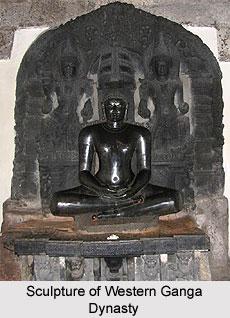 Sculpture of Western Ganga dynasty cannot be distinguished as Dravida style has been adopted. Their sculpture was also influenced by Pallava and Badami Chalukyas. Many edifices have remained either as they were conceived or in transformed versions. However many towns and villages in South Karnataka have retained temples that depict various stages of Ganga sculpture.
Sculpture of Western Ganga dynasty cannot be distinguished as Dravida style has been adopted. Their sculpture was also influenced by Pallava and Badami Chalukyas. Many edifices have remained either as they were conceived or in transformed versions. However many towns and villages in South Karnataka have retained temples that depict various stages of Ganga sculpture.
Manne which was an important city during the regime of Gangas, has retained some brick temples built during the eighth century. They are kapileshvara and Someshvara temples along with a Jaina basadi. The Ramalingeshvara temple at narasamangala in Chamarajanagara talluk is one of the earliest and the best models of the Ganga brick temples. The panels along the inner wall contain carvings depicting stories from Ramayana and Panchatantra. The grandeur of the Ganga style is evident in the temples. The carvings on the inner ceiling of the temples are charming.
The carving on the ceilings of the navaranga is a feature of sculpture of Ganga dynasty. Boga nandishvara temple at Nandi, Adinatha basadi at kambadahalli and the Cavundarya basadi at shravana belagola are the most important places containing many illustrations of the Ganga architecture and sculpture. Chandraprabha basadi built during the reign of Shivamara-2 and iruve brahmadeva of 9th century are other specimens. The Chavundaraya basadi is one of the largest structures in the area. Sculpture of Ganga dynasty exhibits variety. Thin carvings on hard granite stone and well rounded full fledged idols are reminiscent of Buddhist sculptures. Jaina, Shaiva and Vaishnava idols have retained their individuality. Mahisasuramardini icon at Kunigal and nandi, nataraja and umamaheshvara idols at araluguppe and Dharanendra yaksha idol at kambadahali are remarkable.
The great monolithic statue of Bagavan bahubali at shravanabelagola is a masterpiece of sculpture of Western Ganga dyansty.



















